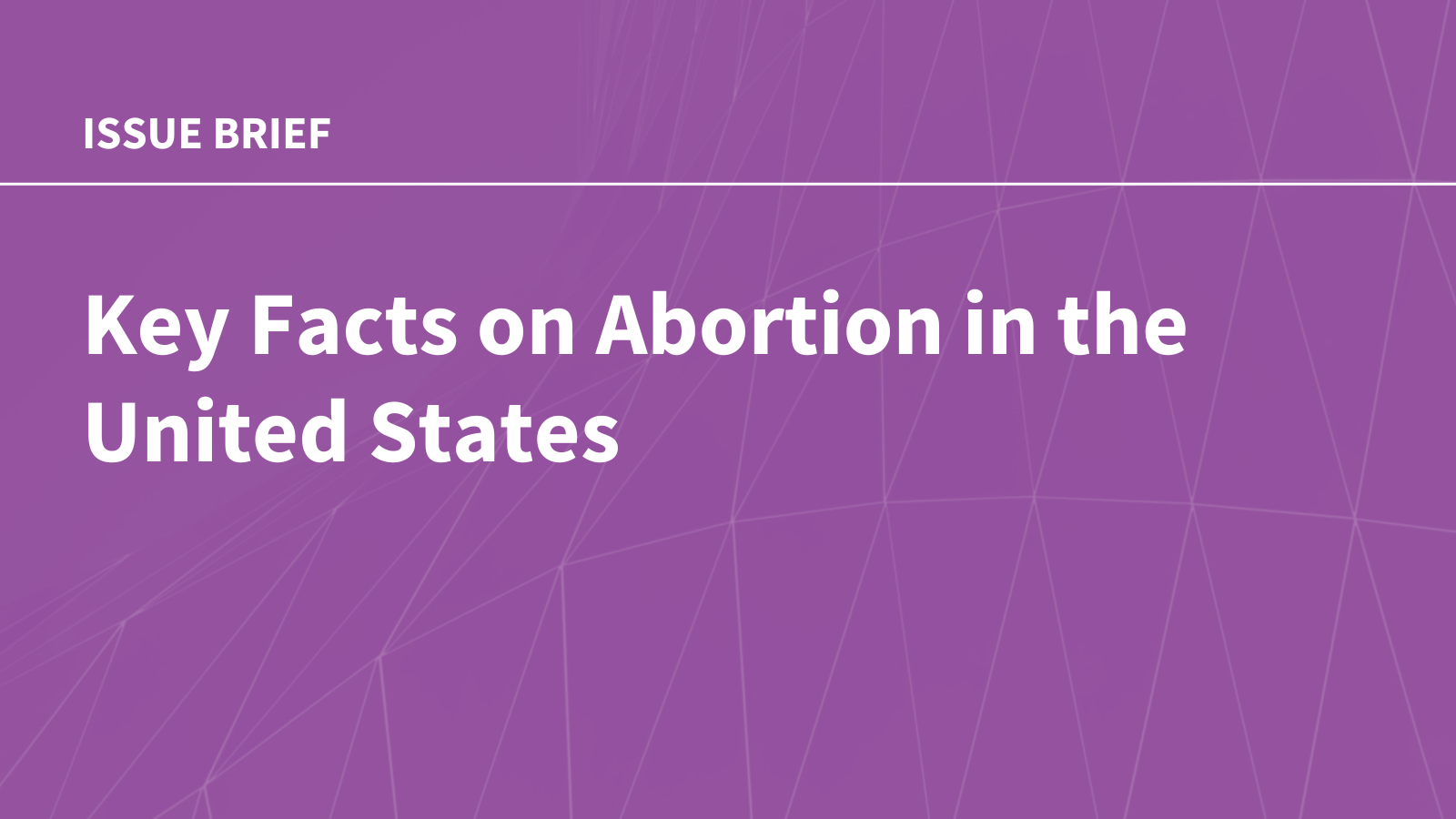Note: This brief was updated on July 15, 2025 to incorporate new data on abortion statistics.
The Supreme Court’s 2022 ruling in Dobbs v. Jackson Women’s Health Organization overturned the constitutional right to abortion that had been in place for nearly 50 years under Roe v. Wade. Prior to the Dobbs ruling, abortions were permitted up to fetal viability in all states. That federal standard was eliminated under Dobbs, allowing states to ban or restrict abortion before viability. KFF is tracking and updating the status of abortion access and availability, with some states banning almost all abortions and some states protecting abortion access.
This issue brief answers some key questions about abortion in the United States and presents data collected before and since the Dobbs ruling.
What is abortion?
Abortion is the medical termination of a pregnancy. It is a common medical service that many women obtain at some point in their life. There are different types of abortion methods, which the National Academy of Sciences, Engineering, and Medicine (NASEM) places in four categories:
- Medication Abortion – Medication abortion, also known as medical abortion or abortion with pills, terminates a pregnancy by oral medications. There are two widely accepted protocols for medication abortion. In the U.S., the most common protocol involves the drugs mifepristone and misoprostol. Typically, an individual takes mifepristone first, followed by misoprostol 24-48 hours later. The U.S. Food and Drug Administration (FDA) has approved this abortion protocol up to the first 70 days (10 weeks) of pregnancy. Another medication abortion protocol uses misoprostol alone, which is also recommended for up to 70 days (10 weeks) of pregnancy, but it is not currently approved by the FDA and is more commonly used in other countries.
The Guttmacher Institute estimates that in 2023, medication was used for almost two thirds (63%) of all abortions. Many have confused emergency contraception (EC) pills with medication abortion pills, but EC does not terminate a pregnancy. EC is a contraceptive that prevents pregnancy by delaying or inhibiting ovulation and will not affect an established pregnancy.
- Aspiration, a minimally invasive and commonly used gynecological procedure, is the most common form of procedural abortion. It can be used to conduct abortions up to 14-16 weeks of gestation. Aspiration is also commonly used in cases of early pregnancy loss (miscarriage).
- Dilation and evacuation abortions (D&E) are usually performed after the 14th week of pregnancy. The cervix is dilated, and the pregnancy tissue is evacuated using forceps or suction.
- Induction abortions are rare and conducted later in pregnancy. They involve the use of medications to induce labor and delivery of the fetus.
What does research show about the safety of abortions?
Decades of research have shown that abortion is a very safe medical service.
Despite its strong safety profile, abortion is the most highly regulated medical service in the country and is now banned in several states. Additionally, many states impose other limitations on abortion that are not medically indicated, including waiting periods and parental notification and consent requirements that typically delay receipt of services.
- NASEM completed an exhaustive review on the safety and effectiveness of abortion care and concluded that complications from abortion are rare and occur far less frequently than during childbirth.
- NASEM also concluded that safety is enhanced when the abortion is performed earlier in the pregnancy. State level restrictions such as waiting periods, ultrasound requirements, and gestational limits that impede access and delay abortion provision likely make abortions less safe.
- When medication abortion pills are administered at or before 9 weeks gestation, the pregnancy is terminated successfully 99.6% of the time, with a 0.4% risk of major complications, and an associated mortality rate of less than 0.001 percent.
- Studies on procedural abortions, which include aspiration and D&E, have also found that they are very safe, with the rate of major complications less than 1% for aspiration abortions. Abortion medications and procedures are also often used for people experiencing miscarriages and stillbirths and can improve safety by preventing delays when a loss is inevitable.
- Most OBGYN physicians say that the Dobbs decision has had a negative impact on maternal health and patient safety. In a national KFF survey of OBGYNs, more than six in ten say that racial and ethnic inequities in maternal health (70%), management of pregnancy-related medical emergencies (68%), and pregnancy-related mortality have all worsened (64%) since the Dobbs
What is the status of abortion policy in the United States today?
Since the 2022 Dobbs ruling, abortion has been banned in 12 states, and another 6 states have implemented early gestational limits between 6 and 12 weeks. Most other states allow abortion to the point of fetal viability, which is generally considered around 24 weeks gestation.
All states that ban abortion have exceptions if an abortion is needed to prevent the death of the pregnant person. Additionally, some state bans make exceptions when the pregnancy is threatening the pregnant person’s health, when the pregnancy is the result of rape or incest, and when there is a lethal fetal anomaly. However, in practice, these exceptions have proven to be unworkable except in the most extreme circumstances. Furthermore, eight states that ban abortion do not make exceptions for cases of rape or incest and six do not have exceptions to protect the health of pregnant people.
How common are abortions?
The most recent data estimates that more than one million abortions (1,141,830) occurred in the U.S. in 2024.
Three different organizations currently track abortion volume at the state and the federal levels: the federal Centers for Disease Control and Prevention (CDC), the Guttmacher Institute, and the Society for Family Planning (SFP). The CDC has been collecting abortion data for decades, but several states do not provide data to the federal government (reporting to the CDC is voluntary) and there is a two-to-three-year time lag until the data become publicly available.
Since the Dobbs ruling, the Guttmacher Institute’s Monthly Abortion Provision Study and the SFP’s #WeCount have been tracking state level changes in abortion volume based on data provided by abortion clinics and providers. Both studies provide national and state-level estimates on procedural and medication abortions but differ in some methodologic details. The Guttmacher study compares current abortion rates to 2020, while #WeCount compares rates to the months immediately before Dobbs in 2022. Neither source includes data on self-managed abortions, which are abortions that a pregnant person can do on their own by taking medication abortion pills without clinical supervision. For more details about data sources, see KFF’s issue brief on abortion trends.
For most of the decade prior to the Dobbs ruling, there was a steady decline in abortion rates nationally, but there was a slight increase in the years just before the ruling. Immediately following the Dobbs ruling, the number of abortions in the U.S. dropped as more states enforced bans and restrictions.
Paradoxically, the most recent data show that the abortion volume in the U.S. slightly increased overall in the two years following the Dobbs ruling.
In 2024, the national abortion volume averaged 95,200 abortions per month, higher than the monthly averages in 2023 and before the Dobbs decision. This overall increase in the number of abortions nationally can be largely attributed to the growth of telehealth for medication abortion, increased availability of lower cost medication abortion pills through virtual clinics, and in particular shield law abortions, where clinicians in legal states are mailing pills to individuals residing in states with bans and restrictions. Additionally, in several states without bans, there has been increased interstate travel for abortion access, expanded capacity to see patients, increased measures to protect abortion rights and improve coverage of abortion care for residents and out-of-state patients, and the broader availability of low-cost abortion medication.
However, the small upswing nationally obscures the massive declines in abortion access to in-state providers in states with bans and restrictions as well as the hardships that many pregnant people experience in accessing abortion care. Additionally, there are month-to-month variations in all states, and changes in policy can cause larger shifts. For example, in May 2024 Florida implemented a ban on abortions after six weeks gestation (previously permitted up to 15 weeks), and subsequently there was a noticeable decline in abortions in the state and nationally.
Who gets abortions?
Most of the information about people who receive abortions comes from CDC data. In 2022, the most recent year CDC data are available, women across a range of age groups, socioeconomic status, and racial and ethnic backgrounds obtained abortions, but the majority were obtained by women who were in their twenties, low-income, and women of color.
- Women in their twenties accounted for more than half (57%) of abortions. Nearly one-third (31%) were among women in their thirties and a small share were among women in their 40s (4%) and teens (9%).
- Information on the race and ethnicity of people who obtain abortions is particularly limited, but based on available data, more than half of abortions were among women of color in 2022. Black women comprised 40% of abortion recipients, 32% were provided to White women, 21% to Hispanic women, and 7% were among women of other races/ethnicities. Additionally, White, Black, and American Indian and Alaska Native women are disproportionately represented among women ages 18-49 in states that have banned abortion compared to states that provide broader access to abortion. Many women who sought abortions have children. Approximately six in 10 (59%) abortion patients in 2022 had at least one previous birth.
The vast majority (93%) of abortions occur during the first trimester of pregnancy according to data available from before the Dobbs decision.
Before the 2022 ruling in Dobbs, there was a federal constitutional right to abortion before the pregnancy is considered to be viable, that is, can survive outside of a pregnant person’s uterus. Viability is generally considered around 24 weeks of pregnancy. Most abortions, though, occur well before the point of fetal viability. When people have abortions later in pregnancy, it is often because the fetus is not viable and the pregnancy may endanger the pregnant person’s life.
- Data from 2022 found that four in ten (40%) abortions occurred by six weeks of gestation, another four in ten (39%) occurred between seven and nine weeks, and 14% at 10-13 weeks. Just 7% of abortions occurred after the first trimester.
Where do people get abortion care?
Abortions can be provided in a variety of settings. Recent data on site of abortion care are limited, but historically the majority of abortions have been provided at brick and mortar clinics that specialize in provision of reproductive health care. Some private office-based physicians also offer abortion services and in more recent years, there has been an emergence of virtual only clinics that offer medication abortions.
Brick-and-mortar clinics vary, but they can offer medication abortion, procedural abortions, and services for abortions later in pregnancy. Many clinics in states where abortion is restricted or banned stopped offering abortion services shortly after the Dobbs ruling and the overall number of brick-and-mortar independent clinics in the US has decreased over the years, with over 75 independent abortion clinics shutting down between 2022 and 2024. Contrary to expectations though, the number of abortions from these clinics increased overall since the Dobbs ruling. The distribution of facilities that offer abortion care varies widely by state and geographic region, and the increase is largely driven by the expansion of virtual abortion clinics. While virtual clinics can remove geographic barriers for those seeking abortion care, their services are limited to medication abortion which is only available to those seeking abortions early in pregnancy. Even prior to the ruling in Dobbs, access to abortion services was very uneven across the country. The proliferation of restrictions in many states, particularly in the South, greatly constrained the availability of services in some areas. In the wake of overturning Roe v. Wade, these geographic disparities have only widened.
Telehealth
Telehealth has grown as a delivery mechanism for abortion services. While procedural abortions must be provided in person in a clinical setting, medication abortion can be provided in a clinical setting or via telehealth without an in person visit. An estimated one in four abortions were provided via telehealth in the last quarter of 2024. Access to medication abortion via telehealth was limited for many years by an FDA policy that permitted only certified clinicians to dispense mifepristone within a health care setting. In December 2021, however, the FDA permanently revised this policy and no longer requires clinicians to dispense the drug in person. Additionally, in January 2023, the FDA finalized a policy change that allows retail pharmacies to dispense medication abortion pills to patients with a prescription. These policy changes opened the door to using telehealth for medication abortion.
- Telehealth can be administered by providers from traditional brick-and-mortar clinics or by virtual-only clinics. Virtual clinics began to proliferate after the FDA revised its in-person dispensing requirement in 2021, rising from no virtual clinics in 2020 to 226 clinics in 2023 (representing 24% of facilities that offer medication abortion).
- In a telehealth abortion, the patient typically completes an online questionnaire to assess (1) confirmation of pregnancy, (2) gestational age and (3) blood type. If determined eligible by a remote clinician, the patient is mailed the medications. This model does not require an ultrasound for pregnancy dating if the patient has regular periods and is sure of the date of their last menstrual period (in line with ACOG’s guidelines for pregnancy dating). If the patient has irregular periods or is unsure how long they have been pregnant, they may need to obtain an ultrasound to confirm the weeks of gestation and rule out an ectopic pregnancy and send in the images for review before receiving medications. The follow-up visit with a clinician can also happen via a telehealth visit.
- Research has found that the provision of medication abortion via telehealth is as safe and effective as the provision of the pills at an in person visit. Yet, in some states that have not banned abortion, telehealth may not be available because of state-level restrictions enacted prior to the Dobbs ruling that require patients to take the pills at a physical clinic, require ultrasounds for all abortions, or directly ban telehealth for abortion care. Of the 36 states that have not banned abortion, 12 had at least one of these restrictions as of March 2024.
- Medication abortion has emerged as a major legal and legislative front in the battle over abortion access across the nation. Multiple cases have been filed in federal and state courts regarding aspects of the FDA’s regulation of medication abortion as well as the mailing of medications.
- Some states have passed shield laws, designed to reduce the legal risks for clinicians who provide abortion care to patients who live in states where abortion is banned or restricted. The shield laws bar the clinicians’ resident state from extraditing them if a restrictive state attempts to prosecute the clinician for performing an abortion that is otherwise legal in their home state. As of September 2024, 8 states have shield laws in place that explicitly protect providers regardless of patient location.
- Data from SFP’s latest #WeCount report show that one in four (25%) abortions were provided via telehealth towards the end of 2024. These telehealth abortions include those provided by brick-and-mortar clinics, virtual clinicians, and clinicians in states with shield laws who prescribe medication abortion to patients in states with bans or telehealth restrictions.
Self-Managed Abortions
Self-managed abortions typically involve obtaining medication abortion pills from an online pharmacy that will send the pills by mail or by purchasing the pills from a pharmacy in another country, usually without the involvement of a physician or advanced practice clinician. While this can involve asynchronous contact with non-US-based clinicians, it does not typically involve a direct consultation with a clinician either in person or via telehealth.
It is difficult to track the volume of self-managed abortions since they are outside of the formal health care system, and it is unknown if all people who receive medication pills take them. One study estimated that at least 26,000 additional self-managed medication abortions took place in the six months following the Dobbs ruling. More than half of self-managed medication abortions pills were distributed through volunteers in community networks, while others were provided by telehealth organizations outside the formal U.S. health care system and online vendors.
Interstate Travel
The Guttmacher Institute Monthly Abortion Provision Study is the only data source so far to provide in-depth information on interstate travel pre- and post-Dobbs. Guttmacher estimates that prior to Dobbs, nearly one in ten people obtained an abortion by traveling across state lines in 2020. Even before Roe v Wade was overturned, abortion was highly restricted in many states. The latest data show that 155,000 patients traveled out of state for abortion care in 2024, a slight drop from 170,000 in 2023 but nearly double the number of travelers in 2020 (81,000). This has been offset by an increase in patients who are getting abortion pills via telehealth.
The states with the highest number of people traveling inbound for abortion care border at least one state where abortion is banned, including Illinois (35,470 patients), North Carolina (16,640 patients), Kansas (15,930 patients), and New Mexico (12,730 patients).
How much do abortions cost?
The costs of abortion services vary widely depending on the method, facility, and gestational age; the costs can be as low as $25 through virtual clinics but typically exceed $1,000 for abortions later in pregnancy.
- Obtaining an abortion can be costly. On average, the costs are higher for abortions in the second trimester than in the first trimester. The state bans and restrictions enacted since Dobbs can also result in additional nonmedical expenses for transportation, childcare, lodging, and lost wages. Many people pay for abortion services out of pocket, but some people can obtain assistance from local abortion funds, or coverage through their insurance plan or with state funds in some states.
- Among all abortion-providing facilities in 2023, the median costs for people paying out of pocket in the first trimester were $563 for a medication abortion and $650 for a procedural abortion. For people with low incomes, who are more likely to seek abortion care, these costs are often unaffordable. The costs of abortion are higher in the second trimester compared to the first, with median self-pay reaching $1000. In the second trimester, more intensive procedures may be needed and local options are more limited in many communities that have fewer facilities.
- Abortion funds are independent organizations that help pay for some of the costs of abortion services, typically medical care, travel, and accommodations if needed. Most abortion funds are regional and have connections to clinics in their area, but they do not reach all people seeking services. Since Dobbs, these networks received a reported 39% more requests for support, and while donations to these networks rose immediately following Dobbs, the frequency of donations slowed, and the resources available to funds have begun to taper.
- The costs for abortion services through virtual clinics, such as AidAcess and Abuzz, as well as self-managed sites, are typically lower than in person services. In 2023, the median cost of medication abortion from virtual clinics was $150. Costs at online pharmacies listed on Plan C range from a low of $25 for abortion pills by mail without clinician consultation, to upwards of $150 for abortion by mail with a clinical consultation.
Does private insurance or Medicaid cover abortions?
Insurance coverage for abortion services is heavily restricted in certain private insurance plans and public programs like Medicaid and Medicare.
Among women of reproductive age, approximately one in three are covered by private insurance, one in five are covered by Medicaid, and one in ten are uninsured. States regulate fully-insured private plans in their state, whereas the federal government regulates self-funded plans. States can choose whether abortion coverage is included or excluded in private plans that are not self-funded. Increasingly, states that support abortion rights have enacted laws that mandate coverage in both Medicaid and state-regulated plans.
Prior to the Dobbs ruling, several states had enacted private plan restrictions and banned abortion coverage from ACA Marketplace plans. Currently, there are 10 states that have policies restricting abortion coverage in private plans and 25 that ban coverage in any Marketplace plans. Since the Dobbs ruling, some of these states have also banned the provision of abortion services altogether. Conversely, 12 states require private plans to cover abortion, nine of which require no cost-sharing for abortion.
For decades, the Hyde Amendment has banned the use of federal funds for abortion in Medicaid, Medicare and other public programs unless the pregnancy is a result of rape, incest, or if it endangers the pregnant persons’ life. States have the option to use state-only funds to cover abortions under other circumstances for those on Medicaid, which 20 states do currently.
Data from 2021, prior to Dobbs, estimated that a quarter (26%) of abortion patients used Medicaid to pay for abortion services, 11% used private insurance, and 60% paid out of pocket. People in states with more restrictive abortion policies were more likely to pay out of pocket compared to people living in less restrictive states.
How does the public view abortion?
KFF’s national polls have consistently found that a majority of the public did not want to see Roe v. Wade overturned and that most people feel that abortion is a personal medical decision. Similarly, findings from the 2024 KFF Women’s Health Survey show 70% of women of reproductive age—the age group that is most directly impacted by state abortion policies—support a nationwide right to abortion.
Furthermore, much of the public supports access to abortions for patients who are experiencing pregnancy-related emergencies (88%), a patient’s right to travel for abortion care (79%), and protecting doctors who perform abortions from legal penalties (67%).
Publisher: Source link










